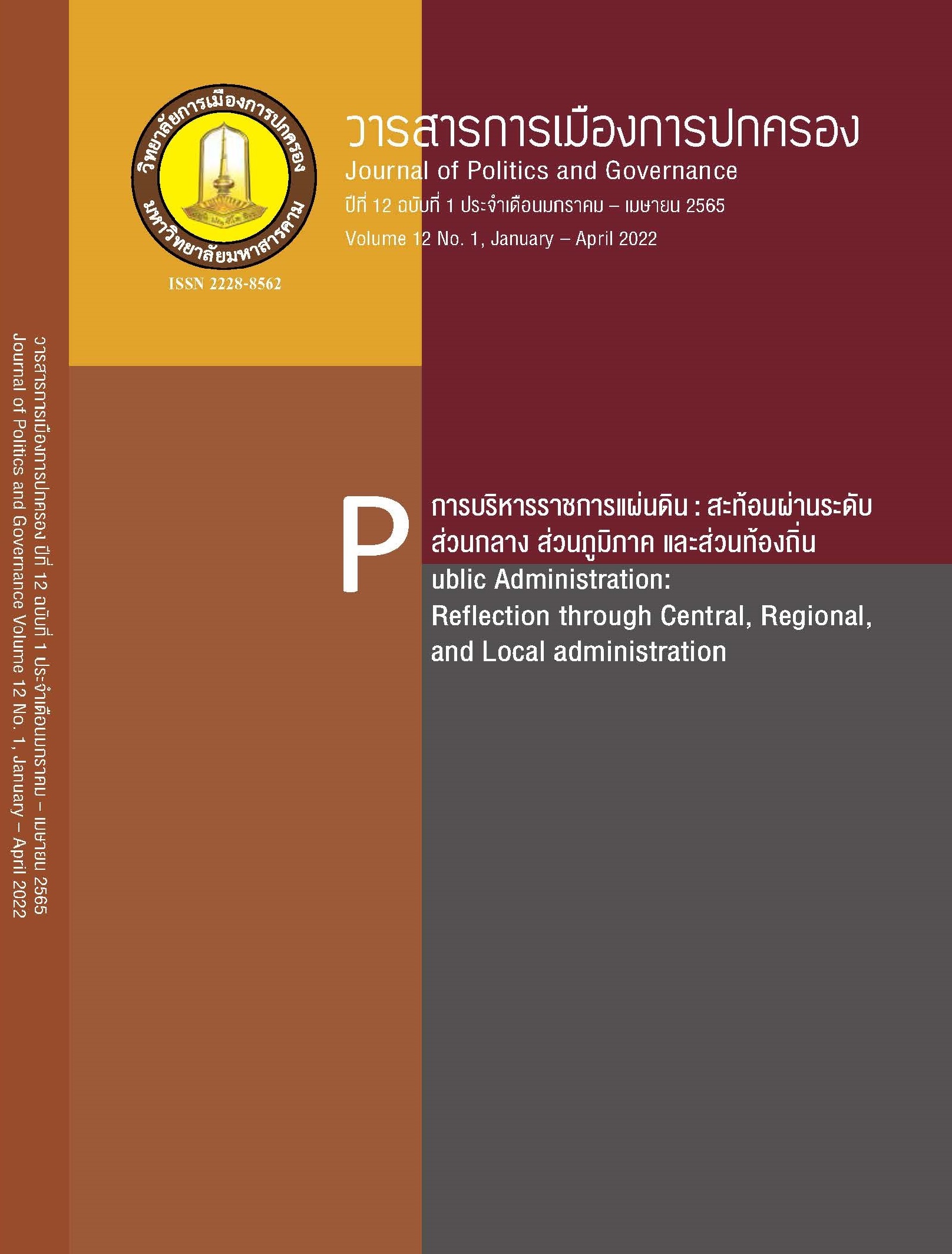การสร้างกระบวนการและกลไกการมีส่วนร่วมในการจัดทำแผนชุมชนเพื่อส่งเสริมสินค้าพื้นถิ่น กรณีศึกษาพื้นที่ตำบลกุดหว้า อำเภอกุฉินารายณ์ จังหวัดกาฬสินธุ์
Main Article Content
บทคัดย่อ
การสร้างกระบวนการและกลไกการมีส่วนร่วมในการจัดทำแผนชุมชน เป็นการศึกษา เพื่อพัฒนากลไกการจัดทำแผนชุมชนแบบมีส่วนร่วม และศึกษาปัจจัยการมีส่วนร่วมของตัวแสดงต่าง ๆ ที่มีส่วนเกี่ยวข้องกับการจัดทำแผนชุมชน โดยการวิจัยเชิงคุณภาพแบบปฏิบัติการแบบมีส่วนร่วม (PAR) มีวิธีการเลือกกลุ่มตัวอย่างแบบเจาะจง (Purposive Sample) และการเลือกกลุ่มตัวอย่างแบบลูกโซ่ (Snowball Sampling) เก็บข้อมูลจากกลุ่มตัวอย่างจำนวน 46 คน ผลการศึกษาพบว่าผู้นำในชุมชนเป็นผู้ขับเคลื่อนหลัก ดังนี้ 1. ผู้นำสร้างความรู้ให้กับกลุ่มผู้นำอื่นและประชาชนในพื้นที่ 2. ผู้นำชุมชนเก็บรวบรวมวิเคราะห์ข้อมูลร่วมกับประชาชน และ 3. ดำเนินการตามแผนขาดการประเมินผลมีกิจกรรมสร้างการมีส่วนร่วม จากการสร้างความเข้าใจในการปฏิบัติ และการเรียนรู้ร่วมระหว่างกระบวนการจัดทำแผนชุมชน ข้อเสนอแนะดังนี้ 1. การจัดทำแผนชุมชนควรเปลี่ยนจากการยึด พื้นที่เป็นที่ตั้ง (Community - Based Planning) ให้ประชาชนในชุมชนร่วมกันดำเนินการ ด้วยตนเอง (Participatory-Based Planning) 2. องค์กรปกครองส่วนท้องถิ่นให้ชุมชนร่วมบูรณาการ 3. มาตรการแบบเหมารวม (One-size-fit-all) ไม่สามารถนำมาใช้ในการพัฒนาการมีส่วนร่วมได้ 4. แผนชุมชนไม่ควรยึดตามกรอบเวลา 5. การวิเคราะห์ข้อมูลควรแยกความต้องการออกจากปัญหา เพื่อเพิ่มกลไกการมีส่วนร่วมของประชาชนในท้องถิ่นที่สามารถปฏิบัติได้อย่างแท้จริง
Article Details
เอกสารอ้างอิง
กรมการพัฒนาชุมชน. (2550). การขับเคลื่อนกระบวนการแผนชุมชน. สำนักเสริมสร้างความเข้มแข็งชุมชน. กรมการพัฒนาชุมชน.
เทศบาลตำบลกุดหว้า. (2561). แผนพัฒนาสี่ปี (พ.ศ.2561-2564). กลุ่มงานสำนักปลัด. เทศบาลตำบลกุดหว้า.
เทศบาลตำบลกุดหว้า. (2561). แผนพัฒนาสามปีองค์การบริหารส่วนตำบลกุดหว้า. กลุ่มงานสำนักปลัด. เทศบาลตำบลกุดหว้า.
ชาย โพธิสิตา. (2547). ศาสตร์และศิลป์แห่งการวิจัยเชิงคุณภาพ. นครปฐม : สถาบันวิจัยประชากรและสังคม, มหาวิทยาลัยมหิดล.
นครินทร์ เมฆไตรรัตน์. (2554). ทิศทางการปกครองท้องถิ่นของไทยและต่างประเทศเปรียบเทียบ. กรุงเทพฯ: วิญญูชน.
วสันต์ เหลืองประภัสร์ และคณะ. (2557). โครงการการสังเคราะห์ตัวแบบเชิงทฤษฎีและการบริหารจากผลการ ดำเนินโครงการวิจัยเพื่อพัฒนากลไกความร่วมมือเพื่อแก้ปัญหาร่วมกันของคนในพื้นที่. โครงการวิจัยเสนอต่อสำนักงานกองทุนสนับสนุนการวิจัย.
วรรณดี สุทธินรากร. (2560). การวิจัยเชิงปฏิบัติการแบบมีส่วนร่วมและกระบวนการทางสำนึก. (พิมพ์ครั้งที่ 2). กรุงเทพมหานคร: สำนักพิมพ์สยาม.
วุฒิสาร ตันไชย. (2547). การกระจายอำนาจและการปกครองท้องถิ่น: ความก้าวหน้าหลังรัฐธรรมนูญ พ.ศ. 2540. กรุงเทพฯ: คลังวิชา.
สุภางค์ จันทวานิช. (2540). วิธีการวิจัยเชิงคุณภาพ (พิมพ์ครั้งที่ 16). สำนักพิมพ์แห่งจุฬาลงกรณ์มหาวิทยาลัย.
สุภางค์ จันทวานิช. (2540). การวิเคราะห์ข้อมลในการวิจัยเชิงคุณภาพ. กรุงเทพมหานคร : สำนักพิมพ์แห่งจุฬาลงกรณ์มหาวิทยาลัย.
Ansell, C., & Gash, A. (2008). Collaborative governance in theory and practice. Journal of Public Administration Research and Theory, 18(4), 543–571.
Agranoff, R, & McGuire, M. (2003). Collaborative public management: New strategies for Local Governments. Washington, DC: Georgetown University Press.
Asnarulkhadi A.S & Fariborz Aref. (2010). The theoretical and conceptual framework and application of community empowerment and participation in processes of community development in Malaysia. Journal of American Science, 7(2).
Chee, S. (1975). Government Policy and Rural Development in Malaysia, in proceeding of a seminar on approaches of rural development in Asia. Kuala Lumpur: Asian Centre for Development Administration.
Cohen, J.M. & Norman T, Uphoff. (1977). Rural development participation: Concepts and measures for project design, implementation and evaluation. Cornell University.
Emerson, K., & Nabatchi, T., & Balogh,S. (2011). An integrative framework for collaborative governance. Journal of Public Administration Research and Theory, 22 (1), 1–29.
Emerson, K., & Nabatchi, T. (2015). Collaborative Governance Regimes. Washington, DC: Georgetown University Press.
Faulkner, D.O. & De. Rond, M. (2000). Perspective on Co-operative Stratrgy. In Faulkner, D.O. and De. Rond, M (Eds). Co-operative Stratrgy: Economic, Business and Orgaisational Issues. Oxford University Press. 3-39.
Gajda, R. (2004). Utilizing Collaboration Theory to Evaluate Strategic Alliances. American Journal of Evaluation, 25(1), 65-77.
Gray, B. (1989). Collaborating: finding common ground for multiparty problems. San Francisco, CA: Jossey-Bass.
Huxham, C. (2000). The Challenge of Collaborative Governance. Public Management Review, 2(3), 337–358.
Siedentopf, H. (1987). Decentralization for rural development. Government approaches.
And people’s initiatives in Asia and the Pacific. In A. Bhatt, L. V. Carino, K. Shams, & G. Sosmena (Eds.), Building from below local initiatives for decentralized development in Asia and Pacific (Vol. 1). Kuala Lumpur: Asian and Pacific Development Center.
Sullivan, H. & Skelcher, C. (2002). Working across Boundaries: Collaboration in Public Services. Basingstoke. Palgrave Macmillan.
Williams, P. & Sullivan, H. (2007). Working in Collaboration: Learning form Theory & Practice. Cardiff: National Leadership and Innovation Agency for Healthcare.

